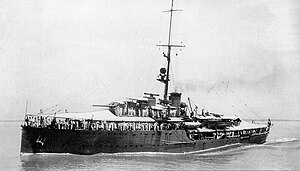Flores class sloops

Flores-class gunboat HNLMS Soemba
|
|
| Class overview | |
|---|---|
| Operators: |
|
| Preceded by: | Brinio class |
| Succeeded by: | Johan Maurits van Nassau |
| Built: | 1925–1926 |
| In commission: | 1926–1956 |
| Completed: | 2 |
| Scrapped: | 2 |
| General characteristics | |
| Type: | Gunboat |
| Displacement: |
|
| Length: | 75.6 m (248 ft 0 in) |
| Beam: | 11.5 m (37 ft 9 in) |
| Draught: | 3.6 m (11 ft 10 in) |
| Installed power: |
|
| Propulsion: | 2 shafts, 2 Triple-expansion steam engines |
| Speed: | 15 kn (28 km/h; 17 mph) |
| Complement: | 145 |
| Armament: |
|
| Armour: |
|
The Flores-class gunboats were a class of two gunboats built in the mid-1920s for the Royal Netherlands Navy. Flores and Soemba were intended to patrol the Dutch East Indies. During World War II, they served in the Royal Netherlands Navy. They were in several ways the most successful surface ships of the Dutch navy during the war.
They were squat ships, both commissioned in 1926, with a relatively heavy armament for their size (three 150 mm (5.9 in) Krupp guns, the same type and calibre as for the cruisers Java and Sumatra). Their main asset was an advanced fire control system that made them very accurate in bombarding shore targets, as a similar gunboat, Johan Maurits van Nassau, demonstrated in 1940 when she silenced a German battery from a distance of some 19 km (10 nmi).
Flores was brought back to the Netherlands at the start of World War II where she patrolled home waters until the Germans invaded in 1940. Slightly damaged, she escaped to Britain and was employed as a coastal escort. Soemba was withdrawn to Colombo in March 1942, before she could be captured or destroyed by the Japanese invasion of the East Indies.
Flores and Soemba were united in the Mediterranean Sea and played an active and successful role in the landings in Sicily, Salerno, Anzio, Garigliano, Gaeta and finally, at the beaches of Normandy in June 1944. The ships came under fire from shore based artillery and bombers many times, but survived all attacks, although they incurred damage several times. British war correspondents referred to them as "the terrible twins".
...
Wikipedia
